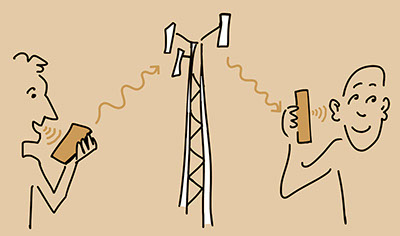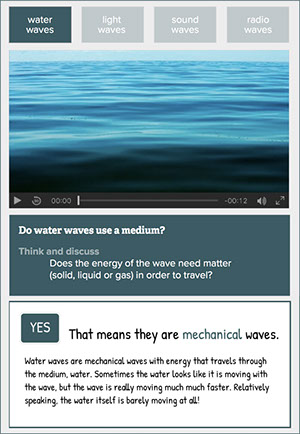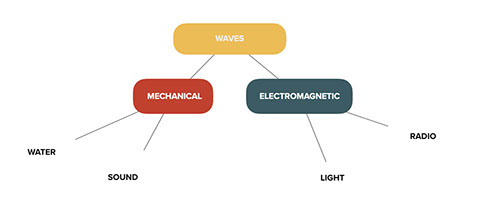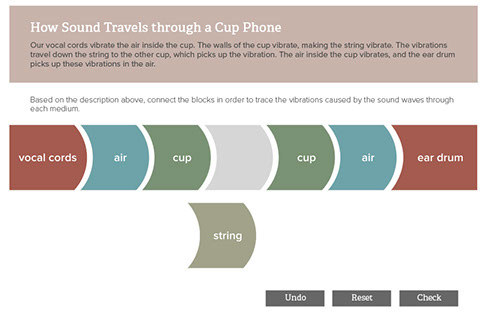SciGen Teacher Dashboard
Flash to Bang
Waves without a Medium
The Electromagnetic Clothesline
Making the Invisible Visible
All-Star Alien Hide and Seek
Lesson: Waves without a Medium
 Duration: Approximately 60 minutes
Duration: Approximately 60 minutes
Compare and contrast two kinds of waves: mechanical (which require a medium of matter to move through), and electromagnetic (which do not require a medium of matter to move through). Explore how the electromagnetic spectrum is used for telecommunications technology. Trace how sound and converted electrical signals travel through different media to get from one's mouth to another’s ear.
LEARNING OBJECTIVES
Students compare mechanical and electromagnetic waves.
Students gain a basic understanding that waves can be used for communication purposes.
Teacher Tips
- The cup phone is one of the demo experiences in E4.5 Sound Stations.
- "Mechanical" waves may sometimes be called "matter" waves because they need a medium made up of matter in order to travel. Choose the term your students are most comfortable with and stick with it.
- Some students may not respond well to the unfamiliar terminology used when describing waves. Judge whether your students would absorb the material better if you use the word "electromagnetic" or abbreviate it "EM." Calling all EM waves "light waves" is simpler and technically accurate (since all EM waves travel at the speed of light) but may confuse students who will think only of visible light. For more on challenges using text, see the SERP materials on Reading to Learn in Science.
- Make enough cup phones for students to try them out in pairs simultaneously, or allow plenty of class time for the cup phone to be passed from student to student.
- Remind students to pull the line of the cup-phone taut between themselves and their partners so it can function properly. They often forget.
- Consider making cup phones with Styrofoam cups or paper cups instead of plastic cups, changing the type of string to yarn, or twine, or even wire or fishing line, and the length of string – students could explore whether those factors make a difference in the quality of the sound, or whether sound is carried better or not.
Materials
- demonstration devices such as a cell phone, portable radio, laptops
- cup-phone(s) — instructions for making one are in the lesson plan for E4.5 Sound Stations
Teacher Tune-ups
Teaching Notes
ACTIVITY OVERVIEW
- Setting the context: What waves are there? (5 minutes)
- Distinguish electromagnetic from mechanical waves (10 minutes)
- Review the simplest "telephones" (10 minutes)
- Medium or no medium listening challenge (30 minutes)
- Writing: Waves are everywhere! (5 minutes)
Setting the context: What waves are there? (5 minutes)
Ask the students to list as many kinds of waves as they can think of. If you'd like, you can use this slide projected onto a white board and annotate it with different kinds of wave names.
Possible answers:
- earthquake
- infrared
- microwaves
- ocean
- radio
- seismic
- sound
- tsunami
- ultraviolet
- visible light
- water
- x-rays
waves
waves
waves
waves
waves
waves
waves
waves
waves
waves
waves
Distinguish electromagnetic from mechanical waves (10 minutes)
Waves exist all around us. It can be overwhelming to think about all the different ways particular kinds of waves work. To help with this, scientists put waves into different categories based on different information.
Let's try it. Can we categorize these four types of waves by thinking about whether they use a medium for their energy to travel?
Explain that two categories of waves are mechanical and electromagnetic. Mechanical waves use a medium for their energy to travel. Electromagnetic waves travel without a medium.
Answers are revealed in the activity. Water and sound waves are mechanical and require a medium in order to travel. Light and radio waves are not mechanical but rather electromagnetic and do not need a medium.
As the students work through the activity, encourage them to take notes about their observations of the waves and their answers to the questions. They could jot down the following:
- type of wave
- mechanical or not
- new vocabulary words (such as "light year")
Note that the speaker used to illustrate sound waves is only generating sound waves: this video is a physical representation of something that is often invisible to the human eye.
Show the slide of the concept map, or build one with your students on the white board to show how the different kinds of waves relate to one another.
In the activity and the concept map, two examples of mechanical waves are given (water waves and sound waves) and two examples of electromagnetic waves are given (light waves and radio waves). Of course there are many other kinds of waves that you may want to add later.
Revisit the list of waves you generated in the prompt, and talk about whether each kind of wave is mechanical or electromagnetic or not a wave at all.
Review the simplest "telephones" (10 minutes)
Students consider how our ears work and how a cup phone transmits sound.
Show the slide of the animated transmission from vocal cord to ear. Ask:
Have you ever wondered how my buzzing vocal cords make sounds that can be heard by your ear drum?
Ask:
How about if you put something in-between, like a cup phone?
Pull out the cup phone(s) and allow students to try it with a partner. They likely have seen cup phones before but may have wondered if they actually work.
(Optional extension: Have available different kinds of cups and lines in different combinations of cup phones. See Teacher Tips for ideas.)
Discuss what makes the cup phone work. Paraphrase:
Our vocal cords vibrate the air inside the cup. The walls of the cup vibrate, making the string vibrate. The vibrations travel down the string to the other cup, which picks up the vibration. The air inside the cup vibrates, and the ear drum picks up these vibrations in the air.
Open the drag-and-drop activity showing How Sound Travels through a Cup Phone.
Ask:
Let's retrace our steps. How do we get from vocal cords to ear drum?
Paraphrase:
But this isn't how our real phones work, is it? How is sound transformed into signals that get sent from point to point from one phone to another? Or how do signals travel in different media in any of the other ways that telecommunication devices work?
Today we are going to trace the path of signals going from your mouth to your friend's ear.
Use the blocks to show the order of different media. In the cup example, air is one medium, the paper of the cup is another medium, and the string is another. Each one vibrates to make the next one vibrate, in mechanical waves that move the matter of each medium.
Ask:
At any point did the sound travel at the speed of light? Did it ever "skip over" needing a medium?
Medium or no medium listening challenge (30 minutes)
In this section, the class will evaluate whether each scenario describing the transmission of sound and sound information uses purely mechanical waves or if it jumps to using the electromagnetic spectrum.
Ask:
The cup phone example isn't how our real phones, work, is it? How does sound get changed into signals that get sent from point to point to get from one phone to another?
Possible answer:
Other kinds of phones use wires instead of strings, and sometimes the signal is changed from a mechanical one to an electromagnetic one and transmitted anywhere, with or without a medium.
Paraphrase:
How do signals travel in different media for other telecommunication devices? Let's go through each of these communication devices and figure out where the signal is a mechanical sound wave moving through a medium and when it has been converted to an electromagnetic signal that travels at the speed of light.
Ask:
Where is there a gap where the signal can travel without a medium?
Students identify which transmissions are electromagnetic that can "jump a gap." Signals are converted to radio and other EM waves in order to travel faster (at the speed of light).
Telecommunications systems are very complicated. The goal in this exercise is not achieving 100% accuracy in the answers but instead recognizing that waves of many forms are used to communicate.
While there are four passages here, you may decide that only one or two of them are enough to review with the whole class. The first one, of the principal using a PA system, is the sole example that uses only mechanical waves.
While one or two of these paragraphs would probably be sufficient for the students to understand, the students would benefit from reading all of the passages. All four scenarios are part of their everyday life. The paragraphs break down how communication works, how it is coded and decoded, etc. They are complicated. Consider having students spending ample time breaking down the steps as well as the types of waves.
You may want to project the passages onto a whiteboard and underline/highlight the parts that use EM waves. As a more challenging assessment, you could ask students to underline the sentences describing transmission of EM waves.
To read to the class:
Principal using the public address system to make a school announcement
The principal speaks into a microphone. The microphone turns these sounds into an electric sound signal of changing voltage. Wire transmits this sound signal to an amplifier. The amplifier sends the signal through a metal cable to two amplifiers. The signal out of the second amplifier moves a magnet that moves a surface inside a loudspeaker. The loudspeaker moves the air in front of it to produce sound waves. These sound waves move out and through the air until those sound waves hit the ear drums of students and teacher listening to what the principal has to say. A volume knob can make sound louder (increasing the amount the speaker moves in and out and the amplitude of the sound wave).
Listening to a favorite deejay on a portable radio
The radio host's voice vibrates the air near the microphone. The microphone turns this into an electric sound signal of changing voltage. An oscillator makes a "carrier signal." The modulator combines the two waves and changes the frequency of the carrier wave. This modulated signal then goes to a strong amplifier. The amplifier sends the signal to a transmitter antenna. The transmitter transmits a radio wave (moving at the speed of light) in all directions, even into space since it doesn't need a medium. In some house far away, there's a radio tuned to the right "FM station" by specifying the frequency of the modulated wave it wants to receive (like 106.7 FM, for example). A wave hits the atoms that make up the radio antenna, creating weak patterns of movement similar to the carrier waves at the radio transmitter. The radio filters out all the other radio signals except the one particular frequency indicated by the radio tuner. It pulls apart the sound signal and the carrier signal. The sound signal gets sent to an amplifier. The amplifier boosts the sound signal and the pattern moves the magnet of the speaker in the radio or headphones. The moving magnet pushes the speaker very slightly in and out, affecting the air so that our eardrums can hear what the radio host said.
Making a mobile phone call to a friend who lives a few states away
You have probably seen cell towers near your home or school. The cell tower assigns specific radio wave frequencies to your phone, and these radio waves are used to transmit and receive your conversation or to send and receive data. As you talk into the phone, air vibrates against its microphone. The phone translates the movement of the microphone into an electrical signal. This electrical sound signal is combined with a carrier signal on your own unique radio frequency. A low-power transmitter in your cell phone sends this radio wave to the closest cell tower or base station, which routes the signal to a relay tower. The tower uses radio waves to beam the signal to a telecommunications satellite orbiting the earth. The satellite beams the signal down to a cellular network which sends the signal to a relay tower near your friend. The relayed signal goes to a cell tower even closer to where your friend is. That cell tower sends a signal to your friend's phone in her unique frequency, and her phone removes the pattern of the electrical sound signal from the radio wave. The electrical sound signal goes to the speaker on her phone to move air to make your voice.
Using a laptop to make an online call to South Africa (like Skype)
When you speak into your laptop, the microphone in your computer turns your voice into a digital sound signal made up of 1s and 0s. The software that converts between analog audio and digital data is called a CODEC, short for "coder-decoder." Your laptop converts this digital signal into radio waves that it can generate. If you are near a wireless hotspot, your laptop can send this digital data wirelessly to the receiver connected to your router. Wireless networks use frequencies of 2.4 to 5 gigahertz (GHz). Next, another piece of software breaks the digital signal into "packets" to send over the Internet. The Internet is made up of wires, metal and fiber-optic cables, and satellite links. The laptop of your friend in Africa receives the data from his Internet connection. A router sends the signal to his laptop, which runs this electrical signal into the decoder part of the CODEC. The computer takes the data and turns it into a signal to send to the speaker. The speaker turns the signal into moving air that your friend hears as the sound of your voice.
Writing: Waves are everywhere! (5 minutes)
Wrap up the session by having the students describe in their own words a way they use mechanical and electromagnetic waves every day.
Describe one way in which you use mechanical waves every day.
_____________________________________________________________
_____________________________________________________________
_____________________________________________________________
_____________________________________________________________
Describe one way you use electromagnetic waves every day.
_____________________________________________________________
_____________________________________________________________
_____________________________________________________________
_____________________________________________________________
BETA Version - Please send comments and corrections to info@serpinstitute.org





